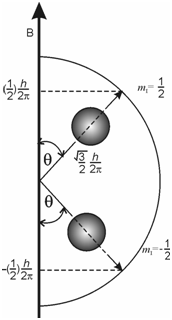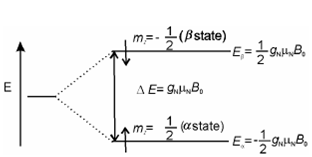Possible orientations of nuclear spin:
The possible orientations for I = ½ are represented in Figure.

Figure: Possible orientations of nuclear spin with I = ½ in a magnetic field B0
You can visualise the orientations of nuclei with spin ½, as either aligned parallel or antiparallel (or opposite) to the external field as shown in Figure. Any other orientation is not possible or permissible. Similarly, for I = 1, 3/2 and 2, the number of possible orientations will be 3, 4 and 5 respectively. The different orientations of the nuclear magnetic moment for the nuclei are associated with different energies. The energies being equal to -mI gN µ B0, where B0 is the strength of the applied magnetic field (applied in the z direction). The energy levels for I = ½ nuclei are given in next figure.

Figure: Energy levels corresponding to mI = + ½ (lower level) and to mI = ½ (upper level) with energy separation of ?E
Traditionally, the energy level (or state, as it is generally called) with mI= ½ is denoted as α and is sometimes described as 'spin up' and the state with mI = - ½ is denoted as β and is described as 'spin down'. For the nuclei we are interested in, it is the α state which is the state with the lower energy. The difference in the energies, ?E, of the two states is given below:
?E = (1/2 g N µ N B0 - (- 1/2 g N µN B0 ) = g N µN B0 )
This implies in which the frequency of the radiation required for a transition from the lower level to the upper level would be given by:
υ = g N µ N .B0/h
For the magnetic fields used in the NMR instruments, this frequency falls in the radiofrequency region of the spectrum. Instead, a appropriate radiofrequency radiation can bring about the transition from the α to β spin state.